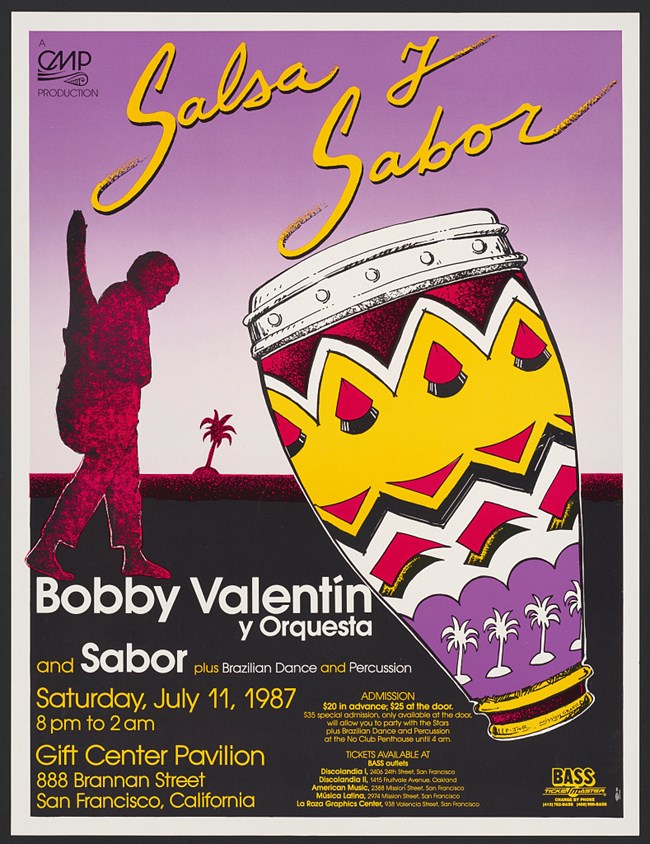Last updated: August 2, 2023
Article
Los Angeles Salsa

Library of Congress, Prints & Photographs Division, © Jos Sances, [reproduction number, e.g., LC-DIG-ppmsca-12345]
Unlike other cities where salsa spread mostly through immigration and social gatherings, LA's influence was associated with entertainment. Dancers in LA were inspired by theatrical dance moves seen in Mexican films, such as La Reina del Mambo (1951) and Al Son del Mambo (1950) and adapted them into their own distinctive style. The city's segregated nature also shaped the way people interacted with salsa dance, with simplified ballroom-style moves for white participants to learn with ease and more street-style dancing in culturally diverse neighborhoods. LA style salsa embraced expansive movements, setting it apart from New York style. Over time, it evolved into a unique form, occasionally clashing with other styles, encompassing different aesthetics, music relationship, and use of space.
LA style salsa emphasizes intricate footwork, spinning techniques, and flashy moves. It often incorporates dips, tricks, and acrobatic elements. LA style salsa is characterized by its smooth and flowing movements, with a strong emphasis on musicality and connection between partners. It often incorporates elements of other dance genres, such as hip-hop, jazz, and contemporary, adding a contemporary feel to the dance. An important figure who shaped the style includes Albert Torres, who created the first salsa congress in the US, one of the largest salsa events in the world. The Vazquez brothers also played a role in the early development of the style. Luis Vazquez co-created the first salsa dance team, Salsa Brava, while Francisco Vazquez’s choreographies established him as a respected figure in the LA dance scene. Josie Neglia is a renowned dancer who began teaching salsa in the 80s by blending salsa with other dance genres. Other dancers such as Super Mario, Eddie Torres, Alex Da Silva, Christian Oviedo, and Liz Lira are also credited for their contributions to shaping LA salsa.
These prominent figures as well as the presence of dance schools and instructors in Los Angeles has helped promote this style to audiences across the US. As these instructors traveled and taught at workshops and festivals globally, they brought the LA style moves to dancers worldwide.
Los Angeles is a Certified Local Government.
Explore photographs taken at the West Coast Salsa Congress held in Los Angeles California at the Hollywood Park Casino in May 2000, 2001, and 2002.
This article was researched and written by Melissa Hurtado, Heritage Education Fellow, Cultural Resources Office of Interpretation and Education.
Aparicio, Frances, and Cándida Jáquez. Musical Migrations, Volume 1: Transnationalism and Cultural Hybridity in Latin/o America. New York: Palgrave Macmillan, 2003.
Bosse, Joanna. "Salsa Dance and the Transformation of Style: An Ethnographic Study of Movement and Meaning in a Cross-Cultural Context." Dance Research Journal 40, no. 1 (2008): 45-64.
García, Cynthia Marie. "Global Salsa: The Politics of Latinidad in Los Angeles Nightclubs." PhD diss., University of California, Los Angeles, 2005.
García, Cindy. "The Great Migration: Los Angeles Salsa Speculations and the Performance of Latinidad." Dance Research Journal 45, no. 3 (2013): 125-136.
García, Cindy. "Dancing Salsa Wrong in Los Angeles." In The Routledge Dance Studies Reader, 285-296. London: Routledge, 2018.
McMains, Juliet E. Spinning Mambo into Salsa: Caribbean Dance in Global Commerce. New York: Oxford University Press, 2015.
